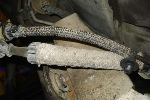Hi Dale, I had to sign up just to comment on your thread.
I didn't see anywhere if you ever managed to get your balancer bolt out, a novel method I've used on cast flywheels might work for you once you get the engine out and on the floor. Normally I'll tie a piece of 1/2" rope around the crank between the block and flywheel as tight as I can get it then wrap about 3 feet of the rope around, tie a loop on the end and hook it around some protruding part of the block or mount bracket. Then just ratchet the crank over until it grabs, lay the engine over on it's side, apply my breaker bar in a near horizontal level and stand on it. I keep an old couch cushion for this to protect the engine and it hasn't failed me yet. Your flexplate will be slippery in comparison to the cast flywheel, but it worked on the pushrod 4.0 we're putting in a 94 Ranger with no damage to the flexplate.
Also, if your engine has a cast aluminum oil pan like the 4.0 Cologne, be very gentle when setting the engine down/moving it around on the floor. Ford cast pans are notoriously fragile.
<rant>
On another note, I have to agree with your sentiments on the designs Ford decides to implement in their engines. I must to say I'm not familiar with the 4.0 OHC engine, but the timing setup on this engine is asinine.
Just from looking at the engine I can see why they've set it up the way they have, but I have to guess at how they're actually doing it. My guess is that this jackshaft you fellows have been speaking of is somewhere in the area of where the camshaft would normally be in a pushrod engine, It runs the whole way through the engine to a sprocket to run a single cam, while the other is run from the front.
They only did that to save on the cost of having to have two different cylinder heads designed and made, and in the process doubled, tripled? the amount of expertise, time, tools and patience required to do this job. Which usually means their dealer gets paid and they get to sell you overpriced parts to fix a bad design. Those chains should be on the front of the engine like on every other automotive design. Not to mention that the system is needlessly complex, is inefficient, and has more parts to wear out (which will, because they're made to "Ford's specification").
As far as your intuition about the chain guides, yeah. There are only a few engines that use guides similar to yours, and they're part of the aluminum block in some of those engines but there's a huge difference. They use roller chains, similar to a bicycle's, roller chains will only take a tiny bit of metal out and then they ride gently on the metal on the bearings in the links, these engines use separate tensioners. Their guides also don't put nearly as much curve into the chain. Before anyone crys 'oh my god metal shavings', how much do you think your hardened steel pump internals care about aluminum powder?
My old MGB had a rubber tensioner that worked in this manner, sacrifice some material initially so the design of the chain works WITH the design of the tensioner. It was 28 years old and didn't need replacing.
In the case of your engine the chain is not long enough to warrant a tensioner or guide on the working side of the chain for any reason, not even slap. If Ford wanted to be paranoid about slap they should have used an idler gear or smooth pulley, not a piece of plastic against steel, those chains don't exactly have the smoothest backsides.
I could go on about Ford's horrible/nonexistant parts interchangeability, or their inferior fasteners, or electrical connectors that require 4 hands to disconnect. I'll spare you.
As far as the sentiment expressed by petetheengineer that some automakers would be glad if they could produce cars that go 100k miles, I would challenge him to name one manufacturer whose cars don't regularly break that. I think he'd be hard pressed to name one with such a bad reputation for not going 150k miles. Even the worst of cars, a Saturn, will do 150k.
If he's proud of his Ford for making it to 100k, I can't imagine how he'd feel about the 260k Honda that just got a new engine because it was easier and cheaper for me to drop a new engine in it than replace the 1 burnt valve, or the 215k Honda that got an engine because I couldn't be arsed to replace the broken front pulley. Those replacement engines came from cars that had been hit hard in the front, and they run better than any 5 year old Ford I've ever been in and they're 17 and 16 years old, respectively.
</rant>
I'm sorry for the long (and angry) post, but let me assure you, I wish you luck and patience. I offer the sympathy of someone who's worked on quality cars but is now working on (seemingly in vain) putting a 4.0 Cologne into a 94 Ranger that came with a 3.0 Vulcan. I'm up to my **** in bad Ford designs, right now you're up to your ankles and the water's just going to keep getting deeper.











